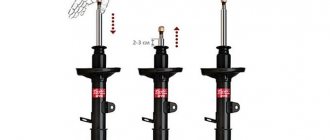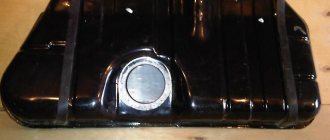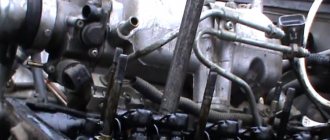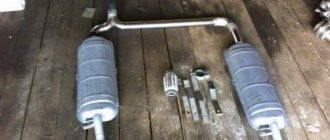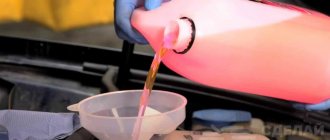Lada Vesta CNG is a modification that allows the use of two types of fuel: compressed natural gas (methane) and gasoline. One of the main advantages of this version is cost-effectiveness. We decided to find out what the real fuel consumption and range of the Lada Vesta with LPG is.
It is worth noting that when using gas, the system still consumes gasoline. This was done to reduce the combustion temperature of the mixture, which reduces the thermal effect on the engine when using gas. According to rough estimates, gasoline consumption is 1-1.5 l/100 km.
Fuel consumption from technical specifications
:
- Urban cycle, l/100 km — 10.1
- Urban cycle, m3/100 km - 8.1
- Extra-urban cycle, l/100 km — 6.0
- Extra-urban cycle, m3/100 km - 5.2
- Combined cycle, l/100 km - 7.5
- Combined cycle, m3/100 km - 6.3
How does it work?
A Vesta bifuel cylinder holds 90 liters, which corresponds to 21–22 cubic meters of gas (the exact volume value is determined by the density of the gas and the pressure in the filling column). The working pressure in the cylinder is 20 MPa at 15°C, and the test pressure reaches 30 MPa. Operating temperature range - from -40 to 55°C.
On a full gas charge, you can travel 300–400 km, and it will cost three times less than with gasoline. And since the 55-liter gas tank remained untouched, Vesta CNG can cover more than a thousand kilometers at one refueling with both types of fuel.
The possibilities for transforming the interior have been reduced to a minimum, but this Vesta travels 1000 kilometers without refueling.
The possibilities for transforming the interior have been reduced to a minimum, but this Vesta travels 1000 kilometers without refueling.
The cylinder ate up a fair share of the usable space of the 480-liter trunk. From it to the rear wall of the luggage compartment no more than five 1.5-liter bottles of mineral water will fit. This (based on the fact that the bottle diameter is 92 mm) is only 460 mm. A regular petrol Vesta has a trunk depth of 920 mm - twice as much. There is also almost no space left above the cylinder - well, you can squeeze in a couple of flat bags. By eye, the actual volume of the trunk has been reduced by almost half (there are no exact factory data yet).
A Chinese 90-liter cylinder holds 18–21 cubic meters. m of gas. Alas, its installation reduced the depth of the trunk by half.
A Chinese 90-liter cylinder holds 18–21 cubic meters. m of gas. Alas, its installation reduced the depth of the trunk by half.
The false floor covering the spare tire has also become half as long. Below that is a new tool tray that wraps around the spare tire, which is partially hidden by the cylinder. It's not scary: getting the spare tire is not much more difficult.
The steel gas pipeline is laid under the bottom and is not covered with anything from below - however, like the gasoline line. The gas pipeline goes under the hood to the receiver, which reduces the pressure and sends the gas further into the ramp, from where it is distributed to the injectors. Under the hood, on the left in the direction of travel, there is a controller that, in case of any unregulated gas consumption, shuts off its supply.
Metal composite cylinder - Chinese manufacturer Sinoma. They say it turned out to be the best in strength. Its guaranteed service life is 15 years, subject to re-examination every five years. The cylinder is clearly visible from the cabin when any part of the rear seat back is reclined - in fact, it blocked the entire opening, so it is now impossible to transport large loads. The valve is accessible from the passenger compartment: it must be closed if the machine is not used for a long period of time. The rest of the gas equipment is from the Italian company Emer.
The trunk area now looks like this. An empty plastic container rattles as it goes.
The trunk area now looks like this. An empty plastic container rattles as it goes.
The filling nipple is hidden under the gas tank flap next to the gasoline filler neck. Any Gazprom CNG filling station will give you an adapter that needs to be snapped onto the fitting. The adapters are mostly Western-made, but we have our own - Russian, more compact, but a little more difficult to use: before snapping it onto the fitting, it must be unscrewed. But in general, the refueling process is simple with any adapter: you need to snap it onto the fitting and insert the gun into it. I gave the money to the cash register and the gas started flowing.
Fully pumping a Vesta cylinder, in theory, takes 10 minutes, but we did it faster - it all depends on the pressure in the column.
What is different about the new interior?
The interior of the model also resembles a gasoline model. Same buttons and switches, same layout of controls. The main difference is a round button for switching from gasoline to gas and a diode indicator of the fuel reserve in the cylinder. Later, the switch will move to the center console and take a place next to the multimedia center, and the indicator will become part of the function of the on-board computer.
Photo of the cylinder in the trunk
A gas cylinder fits in the trunk. It eats up a significant part of the 480-liter trunk. Now its useful volume is 390 liters. At the same time, the spare tire is partially covered by a casing and it has become more difficult to get it out (see photo of the trunk). The developers promise to solve the problem by entering the market of the Lada vesta sw cng station wagon and a crossover based on it sw cross cng.
Is he going?
Judging by the passport data, when switching to gas, Vesta loses 11 hp. power and 15 Nm of torque. Acceleration to hundreds on gas takes 12.2 seconds, while on gasoline it takes 11.8. It is difficult to feel a decrease in power during measured driving. The VAZ-21129 engine fully retains its character, readily spinning up only after 3000 rpm. If you don’t drop the tachometer needle lower, the dynamics of the gas Vesta will satisfy everyone.
Filling fitting, cylinder and gas line leading under the hood. In addition to the receiver, which reduces the pressure to operating pressure, a controller has appeared in the engine compartment that monitors gas consumption. The gasoline tank located under the rear seat remains standard.
Filling fitting, cylinder and gas line leading under the hood. In addition to the receiver, which reduces the pressure to operating pressure, a controller has appeared in the engine compartment that monitors gas consumption. The gasoline tank located under the rear seat remains standard.
In most cases, it is possible to determine what fuel the car is running on only by the indicator above the switch button or during sudden starts from a standstill and during overtaking spurts, when a slight lack of traction is still noticeable. The engine starts always on gasoline (the gas reducer needs a little preliminary warming up), then you can switch to gas power. A forced transition (you need to press a button) from gas to gasoline and back takes a couple of seconds and is accompanied by a soft click of the valve behind the back of the rear seat. There is also automatic switching: if the gas cylinder is empty, the system itself will switch to gasoline power. But in some modes, even when driving on methane, gasoline consumption is small, about 1 l/100 km - it is injected in small doses into the cylinders to reduce the combustion temperature of the mixture and preserve the engine's life.
↑ Self-installation of gas equipment on Lada Vesta
When installing gas equipment yourself, the most important question remains: which gas to choose? The manufacturer chose to use methane. But most gas stations in the country have propane. Today we can say with confidence that propane has many advantages.
In addition to more refills, other positive qualities should be noted. Firstly, the weight of propane cylinders is lower than that of methane. Secondly, they have a large capacity. Therefore, most car owners are inclined towards propane. Perhaps the creation of a gas-powered car that uses methane will change this trend.
What about registration?
Vesta CNG is not a single car equipped with LPG, but a full-fledged serial modification, the first of its kind in Russia. The car has received vehicle type approval (VTA), it will have a factory warranty, an appropriately supplemented service book and a note in the vehicle title about a dual power system. Certification crash tests - frontal, side, rear impact - were passed successfully: there were no gas leaks in any of the tests, the gas equipment remained sealed.
On vehicles not equipped with LPG at the factory, the filler fitting is usually located under the hood. At the gas station, you need to open the gas supply, and after refueling, release the pressure. On the serial Vesta CNG refueling is much more reminiscent of a regular gasoline one.
On vehicles not equipped with LPG at the factory, the filler fitting is usually located under the hood. At the gas station, you need to open the gas supply, and after refueling, release the pressure. On the serial Vesta CNG refueling is much more reminiscent of a regular gasoline one.
When purchasing a car, registering it and further using it, no additional actions will be required from the owner. Inspection and maintenance of gas equipment are timed to coincide with routine maintenance, which Vesta undergoes every 15,000 km. All operations with gas equipment fall on the AVTOVAZ dealer network. According to forecasts, prices for maintenance will be only slightly higher than for gasoline cars, because the only significant operations (in addition to control and inspection) will be the regular change of the air filter cartridge.
Comparison of Lada Vesta CNG 2022 with Renault Logan and Kia Rio
| Comparison parameter | CNG Classic | Renault Logan Access | KIA Rio Classic |
| Engines | |||
| Minimum price in rubles | 609 000 | 499 000 | 699 000 |
| Base motor power (hp) | 106 | 82 | 100 |
| At rpm | 5800 | 5000 | 6000 |
| Maximum torque in Nm | 148 | 134 | 135 |
| Maximum speed in km/h | 172 | 172 | 185 |
| Acceleration 0 – 100 km/h in seconds | 12,6 | 11.9 | 12.2 |
| Fuel consumption (highway/average/city) | 5,5/9,3/6,9 | 9.8/5.8/7.2 | 7.2/4.8/5.7 |
| Number of cylinders | 4 | 4 | 4 |
| engine's type | Petrol | ||
| Working volume in l. | 1,6 | 1,6 | 1,4 |
| Fuel | AI-92/95/methane | AI-92/95 | AI-95 |
| Fuel tank capacity | 55 l/90 l cylinder | 50 l | 55 l |
| Transmission | |||
| Drive unit | Front | ||
| Transmission | Manual transmission | ||
| Number of gears | 5 | 5 | 6 |
| Chassis | |||
| Availability of alloy wheels | — | — | — |
| Tires | R15 | R15 | R15 |
| Body | |||
| Number of doors | 5 | 5 | 5 |
| Body types | Sedan | ||
| Curb weight in kg | 1150 | 1106 | 1080 |
| Permitted weight (kg) | 1580 | 1545 | 1530 |
| Dimensional | dimensions | ||
| Length (mm) | 4410 | 4346 | 4410 |
| Width (mm) | 1764 | 1732 | 1730 |
| Height (mm) | 1497 | 1517 | 1470 |
| Wheelbase (mm) | 2635 | 2634 | 2600 |
| Ground clearance/clearance (mm) | 178 | 160 | 160 |
| Salon | |||
| Trunk volume | 390 | 510 | 480 |
| Options | |||
| ABS | + | + | + |
| On-board computer | + | — | + |
| central locking | + | — | + |
| Rear electric windows | — | — | — |
| Airbags (pcs.) | 1 | 1 | 2 |
| Air conditioner | — | — | + |
| Heated mirrors | — | — | + |
| Front electric windows | + | + | + |
| Heated seats | — | — | — |
| Fog lights | — | — | — |
| Steering wheel adjustment | + | + | + |
| Seat adjustment | — | + | + |
| Stabilization system | — | — | + |
| Audio system | — | — | — |
| Metallic color | 12,000 rub. | 14990 rub. | + |
Where to refuel?
Now about the sad stuff. There are not many compressed natural gas filling stations in Russia - just over three hundred throughout the country (gasoline - over 25 thousand). But there is some progress: in 2016, 35 such stations were built, and this year it is planned to build twenty-five more.
There are currently four CNG filling stations in Moscow and St. Petersburg. The southern and Caucasian regions are of particular interest; the infrastructure there began to develop earlier - dealers are confident that there will be demand for Vesta CNG.
When refueling at a CNG filling station, you will be given an adapter that you need to snap onto the fitting under the hatch. Connect the dispenser hose to the other end and you can refuel.
When refueling at a CNG filling station, you will be given an adapter that you need to snap onto the fitting under the hatch. Connect the dispenser hose to the other end and you can refuel.
Competitors
| Name | Price in euros |
| Volkswagen Polo | From 12750 |
| Ford Fiesta | From 12500 |
| Peugeot 208 | From 12400 |
| Hyundai i20 | From 12200 |
| Opel Corsa | From 11990 |
| Citroen C3 | From 11900 |
| Toyota Yaris | From 11900 |
| Renault Clio | From 10500 |
| Kia Rio | From 10500 |
| Dacia Duster | From 10500 |
| *price indicated as of 04/08/2019. | |
When and how much?
Serial bi-fuel Vestas with a 1.6‑liter VAZ‑21129 engine and a 5-speed JR5 manual transmission will be aimed mainly at taxi work. Dealers have already started accepting orders. Several machines were handed over to potential customers for trial operation. It is planned to make about 600 cars this year; they will be sent to “various commercial structures” in the Moscow region and Tatarstan.
If the regular Vesta 1.6 in the Classic + Start version costs 570,900 rubles, then the CNG version will cost 600,900 rubles. Meanwhile, re-equipping a car at the factory costs 170,000 rubles! Of these costs, the state compensates the manufacturer for 140,000 rubles, so the end consumer overpays only 30,000 rubles, which can be “recovered” quite quickly with active use.
Vesta CNG Comfort is priced at 628,900 rubles, Vesta CNG Lux - at 691,900, and Vesta CNG Luxe + MMS - at 715,900 rubles.
The market is eagerly awaiting the bi-fuel Largus CNG, which is often used for commercial transportation, but it will only arrive next year.
Lada Vesta 1.6 CNG and petrol Vesta 1.6
| Automobile | Power | Moment | Acceleration to 100 km/h | Fuel consumption: combined cycle |
| Vesta 1.6, manual transmission | 106 hp | 148 Nm | 11.8 s | 6.9 l/100 km |
| Vesta 1.6 CNG, manual transmission | 95 hp | 133 Nm | 12.2 s | 6.2 m³/100 km* |
*When driving on gas.
Bi-fuel Lada Vesta - test drive ZR
Content:
- 1 Advantages and disadvantages of gas equipment
- 2 Options and prices
- 3 Lada Vesta CIS: technical characteristics, description
- 4 Gas consumption and range
- 5 How and where to fill a car with gas
- 6 Self-installation of gas equipment on Lada Vesta
A biofuel system can be thought of as a hybrid of gasoline and gas. The car's name now includes three additional letters, CNG, which stand for Compression Natural Gas. Today, the cost of re-equipping a standard Lada Vesta can cost 170,000 rubles. In turn, a new car equipped with gas equipment costs 30,000 rubles more. Therefore, the news that the Lada Vesta CNG will receive a sports version was received very positively.
Features of the CNG configuration
The most interesting thing is that the CNG equipment is divided into several more equipment. These are the configurations:
- Start;
- Classic;
- Comfort;
- Lux;
- Multimedia.
These configurations are distinguished from each other by the presence of certain useful options. More expensive trim levels have a larger number of airbags and are equipped with additional head restraints. Top trim levels are equipped with fog lights and a more advanced multimedia system.
Appearance
Externally, the Lada Vesta in the CNG configuration looks quite attractive, since its design has absorbed many interesting solutions. The front part of the Lada Vesta is made in an X-shaped style, and chrome inserts emphasize this X-shape. Lada Vesta in the CNG configuration is equipped with modern teardrop-shaped optics, which makes the appearance of the car quite aggressive. The X-shaped styling extends to the sides of the car, and this style is emphasized by stamped elements. There is a lot of chrome on the radiator grille, which gives the Lada Vesta a certain charm and sophistication. In the center of the radiator grille there is traditionally the AvtoVAZ emblem, which has increased slightly in size and acquired a new design.
Lada Vesta in CNG configuration is mainly sold in three colors:
- silver;
- black;
- white
But the user can order any color. Two types of rims can be installed on this modification of the car:
- 16 inch;
- 15 inch.
The dimensions of the disks need to be clarified in advance.
Generation choice
At the moment, all gas cylinder installations are divided into 5 generations. Since the Lada Vesta is equipped with simple, in-line power units of atmospheric design, with an injector and distributed fuel injection technology, the fourth generation will be the optimal choice for it.
4th generation HBO scheme.
Earlier generations should not be used, because their technology is currently outdated, and the 5th is intended for turbocharged engines with a direct fuel injection system, which are not available in the Lada Vesta engine line.
5th generation HBO is not suitable for Lada Vesta.

